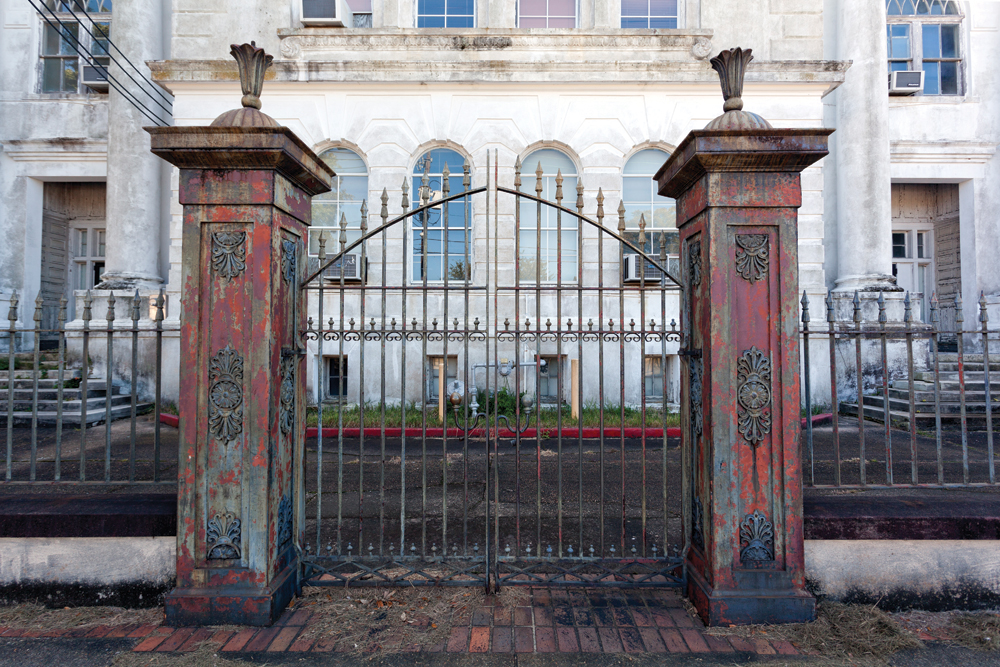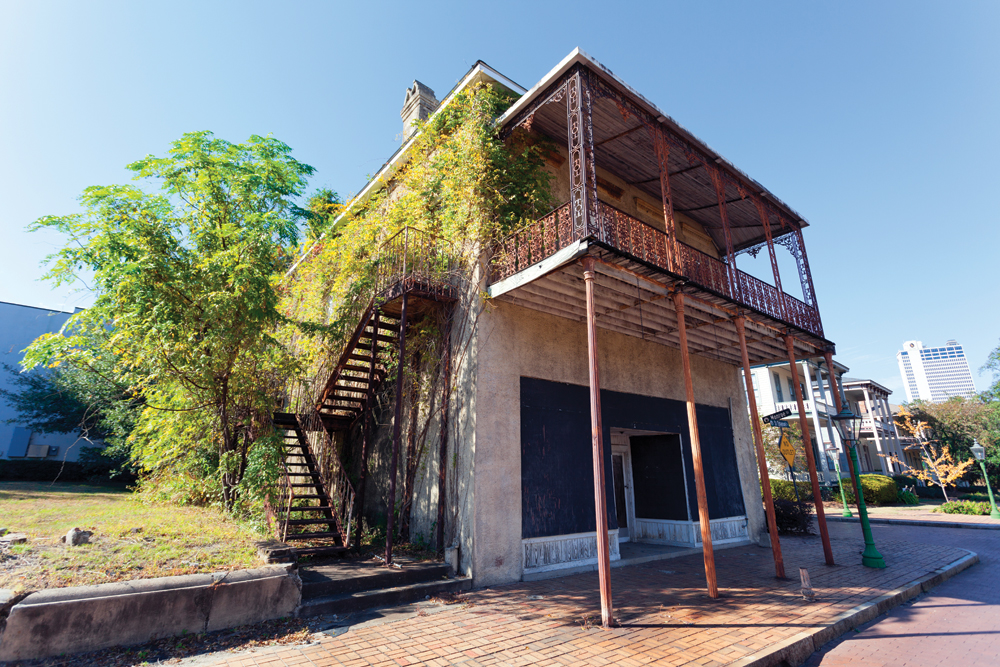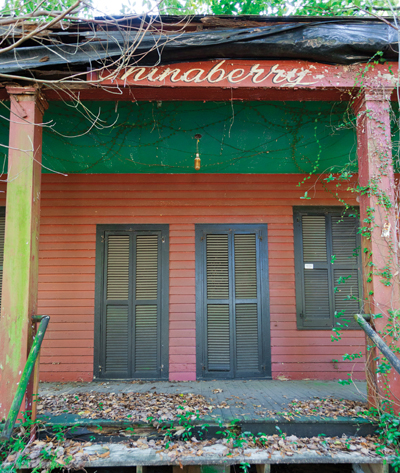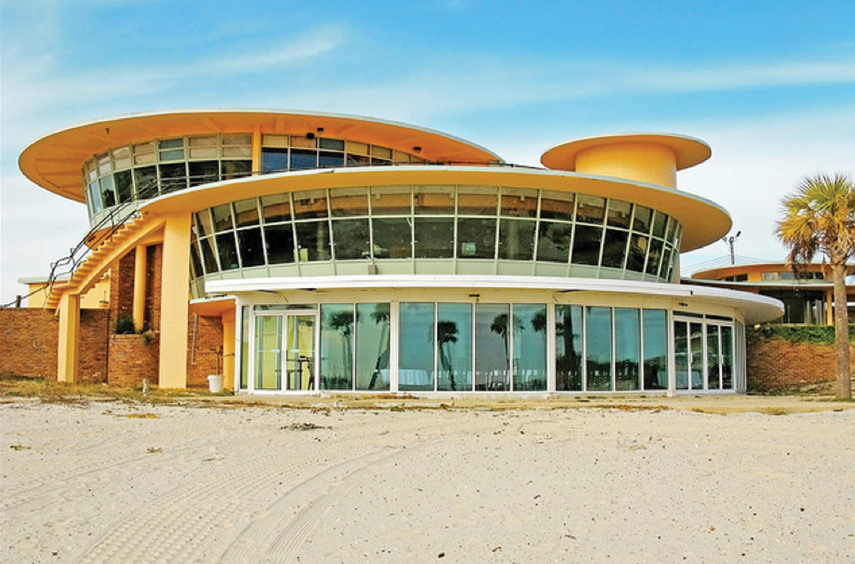Mobile has made tremendous progress on the historic-preservation front in recent years. The Battle House, the GM&O Railroad Building, the Protestant Children’s Home and the Hall-Ford House in Fort Condé Village have all been beautifully restored, and the Van Antwerp Building, recently purchased by the Retirement Systems of Alabama, looks to be the next big project. On a more modest scale, numerous residences and commercial buildings from Marine Street to lower Dauphin sport fresh paint, new roofs, refurbished storefronts and cast-iron balconies. Mobilians’ pride in their unique and diverse architectural legacy is widely evident. Much remains to be done, however, as even a casual drive on area byways will confirm.
The circumstances of a particular dilapidated building, like ownership, location, presence of lead paint, degree of neglect, zoning and broader economic issues, determine whether its restoration may be likely. Generally, the process is more complicated with larger buildings, but smaller ones can also present a bewildering mix of obstacles, even when the owner is ready and able to go to work. It is important in such cases not to lose the building so that an eyesore becomes an overgrown lot. With time, solutions often present themselves.
That said, we preservationists still worry, labor and dream over the Bay area’s endangered historic resources. The following list represents my top 10 choices for a
happy outcome.
1. Barton Academy, 504 Government St.
Built in 1836 by a trio of opportunity-seeking New York architects – James Gallier and the brothers James and Charles Dakin – Barton Academy has lent its regal presence to busy Government Street ever since. A landmark example of Greek Revival style with its columned rotunda floating among the live oak tops, soaring ionic porticoes, symmetrical white lines and distinguished cast-iron fence fronting the broad sidewalk, this building’s decades-long decline and recent abandonment have long been a source of regret. In recent months, the small colonettes surrounding the lantern atop the rotunda have rotted, split and plummeted to the ground, and the rotunda itself appears to be settling into the body of the building that heretofore supported it so well.
Thanks to the efforts of a dedicated group of preservationists, led by Jaime Betbeze and the Save Barton Academy Committee, the venerable old pile’s future could be secure, although significant challenges remain. If I could wave a wand over one building in Mobile, Barton would be it. It defines this community as nothing else does, and its loss would be tragic.

2. The Yerby School, Conti street between Lawrence and cedar streets
Located immediately behind Barton Academy, the Yerby School (above) was constructed shortly after 1900, and in tone, scale and overall massing, closely mimics Barton itself, dome aside. Many people do not think of the Yerby School as a separate building at all, but closer examination shows it to be of obviously later vintage, with different details and flourishes. It is a distinguished building in its own right, and suggestions that it be sacrificed to improve Barton’s restoration prospects are distressing. Yerby should be seen as an asset rather than a liability. A restoration project that saves it easily merits second-place status on my list.
3. Kennedy House-American Legion, 607 Government St.
In 1857, Jonathan Emanuel erected this columned gem as a wedding present for his daughter, Mary, and Joshua Kennedy Jr. In its design, the Kennedy House-American Legion represents a strong blending of Italianate elements with Classical precedent. The two-story stuccoed brick house is imposing, with its monumental Tuscan columns and flattened arches. Furthermore, its bracketed eaves, rounded windows and doors, and highly decorative interior flourishes, like elaborately molded, hooded windows, complete with broken pediments, drop pendants and floral motifs, are all more redolent of the Italianate than the Greek Revival.
Shortly after World War II, the house became the headquarters for American Legion Post 3 and remained in active use until well into the 1990s. Now fallen on hard times, with a collapsing, non-historic, cinder-block rear addition, broken windows and regular visits by the homeless, the building is in dire need of protection and rehabilitation. It is a signature building Downtown, highly visible and running out of time.


LEFT Kennedy House-American Legion, RIGHT Chigahizola House
4. Chigahizola House, 6 S. Franklin St.
Located Downtown to the rear of the cathedral, this two-story brick townhouse is one of the more romantic unrestored residences left in the city. Built around 1852 by Jacques Chigahizola, it features a wrought-iron cantilevered balcony, sans wooden decking, and a magnificent battered architrave surrounding its side entrance. Presently used for storage, the interior is largely unaltered, and even includes penciled graffiti from the 19th century on its plaster walls. Though the building looks bad, it has a decent roof. Nonetheless, its restoration would make a definite difference along the lower Dauphin corridor.

5. Antomanchi Store, 200 St. Emmanuel St.
This masonry building, above, is one of only two yet-to-be-renovated historic buildings in Fort Condé Village. Built in 1869 by a Corsican émigré named Charles Antomanchi, the two-story building served as a store (with an apartment above) for many years. Among its commercial incarnations were an upholstery shop, an oyster saloon, a grocery, and during Fort Condé’s first reclamation in the 1970s, an antiques store.
Vacant for many years, the building is still in salvageable condition, with solid walls and floors. As a surviving commercial / residential Downtown property, with a nice two-story balcony to boot, the Antomanchi store is an important piece of the city’s past.
6. Residence, Basil Street
Situated just south of Martin Luther King Jr. Avenue in the Campground Historic District, this big circa-1910 house is a rare two-story example of residential architecture in one of the city’s oldest black neighborhoods. The Campground was so named because it was a militia parade ground before the Civil War, a Confederate one during the war, and a Union army bivouac afterwards. As the 20th century progressed, the open area was divided and sold off and hundreds of houses erected.
Unfortunately, the home’s serious roof problems are radically compromising the integrity of the structure. While peeling paint and rotting wood present an unsightly appearance, these are essentially cosmetic issues that do not present an emergency unless left unaddressed for too long. Roof trouble is more unforgiving, and this house needs help now.


LEFT Residence, Basil Street; RIGHT Chinaberry, 3703 Old Shell Road
7. Chinaberry, 3703 Old Shell Road
Speeding west along Old Shell Road, just as it begins to incline toward Spring Hill, few motorists notice the barn-red treasure gently succumbing to earth on the south side of their route. Popularly known as Chinaberry and so designated by a rotting wooden sign along its front eave, this charming Creole cottage was built around 1862 by Philip Pfau. During the 1950s, Anne Randolph Crichton, whose father founded the town of Crichton, lived here and tended a lovely garden.
Vacant and neglected for many years, Chinaberry has been steadily encroached upon by the tangled foliage around it, and today it is hardly visible. Eave rot and deterioration of the delicate porch railings have proceeded apace, and if nature’s course isn’t arrested soon, this mid-19th-century house will become a thing of the past.

Photo by Sharon Whelton
8. Isle Dauphine Club, 100 Orleans Ave., Dauphin Island
Nestled amid the dunes and facing the Gulf of Mexico, the Isle Dauphine Club (above) opened in 1957, and its concentric lines and elegant styling perfectly conjure the “Mad Men” era. Mobile architect Arch Winter, who was on the design team, described the place as “a precisely articulated system of circles” like one would find in “a fine Swiss watch.” Among the many delightful features are a spiral staircase, iron handrails, mahogany trim, a wonderful terrace with sweeping beach views, the old Tiki Bar’s exposed beams arranged in a wheel pattern on the circular ceiling, plate glass windows and doors, and a round swimming pool.
The club has fallen on hard times after a succession of tenants and punishing hurricanes. But the biggest threat it faces is the belief that the land is more valuable than the quirky building that sits on it. The Isle Dauphine Club’s fate now lies with the Dauphin Island Property Owners Association, which hopefully recognizes how a carefully managed redevelopment of this unusual architectural set piece could most fully realize the many assets of the stunning locale.
9. American Legion, 700 S. Mobile St., Fairhope
In 1912, prominent Mobile architect George Rogers built this two-story frame building as a summer retreat for the Women’s Club of Mobile. It featured glorious double-decked wraparound porches facing the Bay, banks of full-height doors, and massive hip roof dormers with casement windows. In a stiff breeze, standing inside this building must have felt like being in a wind tunnel, just what one desired in the days before air-conditioning.
In subsequent decades, the wonderful porches were infilled and the building vinyl-sided. Otherwise intact and actively used by the American Legion, a recapture of this building’s original character would radically improve the Fairhope bayfront.


LEFT American Legion, Fairhope; RIGHT Wreck of Rachel, Fort Morgan Road
10. Wreck of The Rachel, Fort Morgan Road at mile marker 6, on the beach
When recent storms uncovered the ribbing of this historic shipwreck, fanciful speculation ran wild. Intrigued observers imagined everything from an old blockade-runner or a pirate ship to a rumrunner. The reality, as it turns out, is that this vessel was an early 20th-century lumber schooner, built on the Mississippi coast in 1918 and wrecked during an October hurricane in 1923. Fortunately, all the crew escaped, but the Rachel was a total loss, and a subsequent fire burned her to the keel. Periodically covered and uncovered with sand in its dynamic coastal environment, the ship is now exposed.
The Rachel seems like an appropriate last entry on my wish list, as so much of Mobile’s colorful maritime history has been lost to the elements and the ravages of time. If only the Rachel could be retrieved (and if not fully restored with all her masts and rigging, at least put on display somewhere), then a piece of this culture would remain to provoke wonder and to inspire.
That, after all, is what the past reclaimed does best of all. MB
John S. Sledge’s new book, “Southern Bound: A Gulf Coast Journalist on Books, Writers, and Literary Pilgrimages of the Heart” is due in March 2013 from the University of South Carolina Press. Look for an excerpt in the March issue of Mobile Bay.
text by John S. Sledge • photos by Michael Mastro





